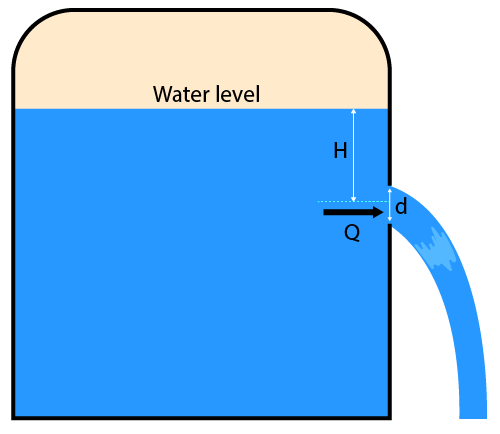Coefficient of Discharge Calculator
The coefficient of discharge calculator will help you determine the ratio between the theoretical and actual discharge or flow rate values for a fluid flow. Whether it is water supply to your house, gas pipelines, or water in an artificial canal, the estimated or theoretical fluid flow used to design these systems is always higher than the actual flow rate for fluids.
The difference is in a hydraulic system's irrecoverable losses (learn more about friction losses using our friction loss calculator). Therefore, a parameter, discharge coefficient, is introduced into the calculations to account for the reduction in the flow rate. It is a function of area, flow rate (see flow rate calculator), and head or pressure drop. So what is it all about? Read on to understand how to calculate the coefficient of discharge.
What is discharge coefficient?
In simple terms, the discharge coefficient is the ratio of theoretical and actual flow rates. The coefficient of discharge is a dimensionless parameter. It is one of the three hydraulic coefficients, which are:
- Coefficient of discharge, ;
- Coefficient of contraction, ; and
- Coefficient of velocity, .
While the coefficient of discharge deals with the flow rate, the coefficient of contraction is associated with the change in the area of the cross-section (find out about different calculations in our cross sectional area calculator) and area of the jet. Lastly, the coefficient of velocity relates to a fluid jet's actual and theoretical velocities. The three hydraulic coefficients are related to each other using the equation below.
Discharge coefficient — Orifice, venturi, weir, open channel flows and others
Consider a fluid flow with a constant cross-sectional area. The coefficient of discharge, is:
where:
- – Actual discharge; and
- – Theoretical discharge.
The actual discharge can be measured at one end of the orifice and denoted as or whereas the theoretical discharge is given by the equation:
where:
- – Density of fluid;
- – Area of cross section;
- – Flow velocity;
- – Change in pressure;
- – Acceleration due to gravity; and
- – Head of fluid i.e., the height or elevation of top surface of liquid.
Therefore, the coefficient of discharge becomes:
In most cases, the discharge coefficient value is between 0.6-0.65. The discharge coefficient is also related to the flow resistance, which is the resistance offered by the surroundings in which the fluid flow occurs. The flow resistance, , is related to the coefficient of discharge as:
How to calculate coefficient of discharge
To calculate discharge coefficient:
- Select the
modebased on the parameters available to you. You can either calculate this discharge coefficient parameter using the hydraulic head or the change in pressure. - If the cross-section is circular, you can enter the pipe diameter, .
- Enter the area of cross-section, .
- Insert the fluid head, .
- Fill in the actual discharge, .
- The calculator will return the coefficient of discharge and flow resistance.
Gravitational accleration
If you wish to adjust the value of acceleration due to gravity, you can enable this calculator's advanced mode.
Example: Using the coefficient of discharge calculator
Find the actual discharge for a fluid flow through an orifice (refer orifice flow calculator) having a diameter of 40 mm and head 10 m. Take the coefficient of discharge for the orifice meter as 0.6.
- Select the
modeusing hydraulic head. - Fill in the diameter, .
- The calculator will return the area of cross-section, .
- Insert the fluid head, .
- Fill in the discharge coefficient, .
- The actual discharge, is:
- The flow resistance, is:
Now let's try another example. Use the calculator to find the change in pressure for a fluid flow through a 50 mm orifice at a mass flow rate of 20 kg/s. Take the coefficient of discharge as 0.909.
To estimate the change in pressure:
- Select the
modeusing change in pressure. - Fill in the diameter, .
- The calculator will return the area of cross-section, .
- Enter the mass flow rate, .
- Fill in the discharge coefficient, .
- The change in pressure, is:
FAQ
What do you mean by discharge coefficient?
The discharge coefficient is the ratio of actual discharge to the theoretical discharge for a fluid flow. It is used to estimate the losses for a system and is among the three hydraulic coefficients, along with velocity coefficient and contraction coefficient.
How do I calculate theoretical discharge?
To calculate theoretical discharge using head:
- Multiply the hydraulic head with acceleration due to gravity.
- Multiply the resultant by
2. - Find the square root of the product.
- Multiply the resulting value by the area of cross-section to obtain the theoretical discharge for a fluid flow.
How do I calculate actual discharge?
To calculate actual discharge:
You'll need — stopwatch, a bucket with its capacity known.
- Start the fluid flow.
- Begin the timer as the bucket starts to fill.
- Stop the timer when the bucket is filled.
- Divide the bucket's capacity with the time duration to find the actual discharge.
How do I calculate discharge coefficient for an orifice flow?
To calculate discharge coefficient:
- Multiply the hydraulic head by the acceleration due to gravity.
- Multiply the resultant by
2. - Find the square root of the product.
- Multiply the resulting value by the area of cross-section to obtain the theoretical discharge for a fluid flow.
- Divide the actual discharge by the theoretical discharge to obtain discharge coefficient.
